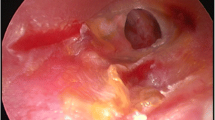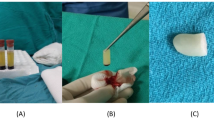Summary
We analyzed those failures occurring in 417 myringoplasties. Forty-four drum re-perforations were found (10.6%), half of which occurred immediately after operation. Causes of these early failures included necrosis in the middle of the graft without infection (10 ears) and blunting of the anterior margins of the graft (7 ears). Infection was the most common cause of re-perforations in the later failures. Re-perforations also occurred more frequently when larger perforations were closed in contrast to repair of small ones. We found that other pre-operative factors (“dry” or “wet” ear, site of the perforation) or grafting technique (“underlay” or “overlay”) did not affect the graft take-rate. Adhesive eardrums were found in 23 ears (5.5%). These were more common when ears were infected pre-operatively, when middle ear mucosa was removed during the primary operation, or when squamous epithelium was present on the tympanic mucosa. Lateralization of the grafted eardrum was found in two cases (0.5%), both of which had been operated on using the sandwich technique.
Similar content being viewed by others
References
Adkins WY, White B (1984) Type I tympanoplasty: influencing factors. Laryngoscope 94:916–918
Booth JB (1973) Myringoplasty. Factors affecting results. J Laryngol Otol 87:1039–1084
Gibb AG, Sing-Kiat C (1982) Myringoplasty. J Laryngol Otol 96:915–930
Glasscock ME (1973) Tympanic membrane grafting with fascia: overlay vs. undersurface technique. Laryngoscope 88:754–770
Hough JVD (1970) Tympanoplasty with the interior fascial graft technique and ossićular reconstruction. Laryngoscope 80:1385–1413
Mendel L, Kuylenstierna R (1980) Healing and hearing in uncomplicated myringoplasty. J Laryngol Otol 94:997–1003
Packer P, Mackendrick A, Solar M (1982) What's best in myringoplasty: underlay or overlay, dura or fascia? J Laryngol Otol 96:25–41
Palva T, Palva A, Kärjä J (1969) Myringoplasty. Ann Otol Rhinol Laryngol 78:1074–1080
Puhakka H, Virolainen E, Rahko T (1979) Long-term results of myringoplasty with temporalis fascia. J Laryngol Otol 93:1081–1086
Sade J, Berco E, Brown M, Weinberg J, Avraham S (1981) Myringoplasty. Short and long-term results in a training program. J Laryngol Otol 95:653–665
Sheehy JL (1964) Tympanic membrane grafting: early and long-term results. Laryngoscope 64:985–998
Author information
Authors and Affiliations
Rights and permissions
About this article
Cite this article
Vartiainen, E., Kärjä, J., Karjalainen, S. et al. Failures in myringoplasty. Arch Otorhinolaryngol 242, 27–33 (1985). https://doi.org/10.1007/BF00464402
Received:
Accepted:
Issue Date:
DOI: https://doi.org/10.1007/BF00464402




